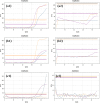Design optimization and validation of UV-C illumination chamber for filtering facepiece respirators
- PMID: 38439842
- PMCID: PMC10909644
- DOI: 10.1016/j.heliyon.2024.e26348
Design optimization and validation of UV-C illumination chamber for filtering facepiece respirators
Abstract
In this study, we constructed an UV-C illumination chamber using commercially available germicidal lamps and other locally available low-cost components for general-purpose biological decontamination purposes. The illumination chamber provides uniform illumination of around 1 J/cm2 in under 5 min across the chamber. The control mechanism was developed to automate the on/off process and make it more secure minimizing health and other electrical safety. To validate the decontamination efficacy of the UV-C Illumination Chamber we performed the Geobacillus spore strip culture assay. Additionally, we performed the viral load measurement by identifying the COVID-19-specific N-gene and ORF1 gene on surgical masks. The gold standard RT-qPCR measurement was performed to detect and quantify the COVID-19-specific gene on the mask sample. The biochemical assay was conducted on the control and test group to identify the presence of different types of bacteria, and fungi before and after exposure under the illumination chamber. The findings of our study revealed satisfactory decontamination efficacy test results. Therefore, it could be an excellent device in healthcare settings as a disinfection tool for biological decontamination such as SAR-CoV-2 virus, personal protection equipment (PPE), (including n95, k95 respirators, and surgical masks), and other common pathogens.
Keywords: Biological decontamination and pathogens; Decontamination efficacy; Facepiece respirators; Personal protection equipment (PPE); SAR-CoV-2 virus; UV-C illumination chamber.
© 2024 The Authors.
Conflict of interest statement
The authors declare that they have no known competing financial interests or personal relationships that could have appeared to influence the work reported in this paper.
Figures










Similar articles
-
Filtering Facepiece Respirator (N95 Respirator) Reprocessing: A Systematic Review.JAMA. 2021 Apr 6;325(13):1296-1317. doi: 10.1001/jama.2021.2531. JAMA. 2021. PMID: 33656543
-
Principles and practice for SARS-CoV-2 decontamination of N95 masks with UV-C.Biophys J. 2021 Jul 20;120(14):2927-2942. doi: 10.1016/j.bpj.2021.02.039. Epub 2021 Mar 4. Biophys J. 2021. PMID: 33675766 Free PMC article. Review.
-
Decontamination Methods for Reuse of Filtering Facepiece Respirators.JAMA Otolaryngol Head Neck Surg. 2020 Aug 1;146(8):734-740. doi: 10.1001/jamaoto.2020.1423. JAMA Otolaryngol Head Neck Surg. 2020. PMID: 32614377 Free PMC article. Review.
-
Fast inactivation of coronavirus in filtering-facepiece respirators in a reflective cylindrical UV-C chamber.J Photochem Photobiol. 2022 Dec;12:100151. doi: 10.1016/j.jpap.2022.100151. Epub 2022 Nov 18. J Photochem Photobiol. 2022. PMID: 36415588 Free PMC article.
-
Scalable, effective, and rapid decontamination of SARS-CoV-2 contaminated N95 respirators using germicidal ultra-violet C (UVC) irradiation device.medRxiv [Preprint]. 2020 Oct 6:2020.10.05.20206953. doi: 10.1101/2020.10.05.20206953. medRxiv. 2020. Update in: Sci Rep. 2021 Oct 7;11(1):19970. doi: 10.1038/s41598-021-99431-5. PMID: 33052360 Free PMC article. Updated. Preprint.
References
-
- K O H e al Ultraviolet germicidal irradiation of filtering facepiece respirators: a systematic review. J. Hosp. Infect. 2020;106(2):163–175. - PubMed
-
- Purschke M., et al. Construction and validation of UV-C decontamination cabinets for filtering facepiece respirators. Appl. Opt. 2020;59(25):7585–7595. 09/01/2020. - PubMed
LinkOut - more resources
Full Text Sources
Miscellaneous

